Morphology
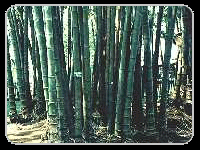
Bamboo is a complex, woody stemmed perennial grass belonging to family Poaceae. The portion of bamboo below the ground level is called rhizome, which forms the vital source for its perennial growth. Roots are produced by the rhizome and also extend up to the lower nodes of the stems that are below the soil. The tall, cylindrical, persistent culms with the branches and leaves form the clump above the ground level. The culms and branches during their initial growth are protected by sheaths. The leaf blades are flat, multi-nerved, often with transverse veins, usually with a petiole-like base which is articulated with the sheath. Based on the structure and growth characteristics of the clump, bamboos have been broadly categorised into four different forms :

The rhizome spreads horizontally beneath the soil and produces both roots and shoots from its nodes. There are two broad types of rhizomes i.e. sympodial and monopodial. Sympodial rhizomes grow in cluster and form clump by producing buds from their nodes at short intervals in different direction. The bamboo produces from this type of rhizomes is thick and strong. Monopodial rhizomes continue to grow horizontally and produce buds at long intervals and hence do not form clumps. Most of the Indian bamboos have sympodial rhizome. The sympodial rhizomes generally grow at an upward inclined angle. The angle of inclination depends on the species and the condition of soil. Rhizomes may grow in any direction depending upon the soil condition and new culms may appear both on periphery and inside the clump.
New buds are produced from the youngest (one year old) rhizomes. The older rhizomes generally do not take part in the production of new culms. In rare cases, where climatic conditions are very favourable, 2-3 year old rhizomes may produce new culms.
Two kinds of buds are produced by the rhizome i.e. the scaly pointed buds and the flat buds. The former develops into new rhizome below the ground and the later grows above the ground to form a culm.
The number of new culms produced annually by a clump depends upon the health of the clump, soil and climatic conditions. The culm buds emerge out of the soil immediately after the pre monsoon showers. However in moist conditions the culms may appear earlier.
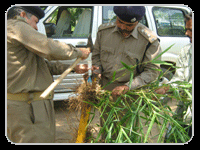
Adequate soil cover over the base of clumps favours the rhizomes for growth, development and production of new culms. Exposure to sunlight stops the growth of rhizome. In eroded sides the production of culm is reduced both in number and size and ultimately the clumps growth becomes stunted and congested. Culm The buds from the rhizomes, which grow above ground are called culm or stems commonly referred to as bamboos. These are hollow (sometimes solid) cylindrical, jointed and tapering upwards. They may be erect or arching outward after certain height. The joints of culm are called nodes from where the branches and leaves spread. The lower nodes also produced roots. The upper nodes half dormant buds which can grow to new shoots and roots under specific treatment. During young stage the culms are covered with sheath at each inter node, which falls off as the bamboo grows. The exposed upper part of the inter nodes is sometimes covered with waxy powder and hairs, which disappears subsequently. Unlike trees, bamboo does not acquire more diameter as it grow. The new culm emerges with full diameter and it reaches full height in 60 to 120 days. The rate of growth varies between 5 cm per day to 40 cm a day.
It is said that the bamboos are the worlds fastest growing plants. Though the culms do not grow in diameter after attaining maximum height, they continue to change in density and strength properties. The successive elongation of the internodes causes height growth. The basal internode is the first to grow and the top-most one is the last. However several internodes grow simultaneously from the bottom upwards and 40-50% of daily height growth is contributed by only 4-6 internodes. The base of an internode is the most active part show far as growth is concerned.
Most of the bamboos have hallow culms. The wall thickness varies from species to species. The strength is directly proportional to its wall thickness. In some localities Dendrocalamus strictus and Bambusa tulda used to develop solid culm: may be due to edapho-climatic or genetical variation.
The culms are very tender during the early growing period. In certain parts of the state this tender culms are cut to be used as vegetables and pickles. Such practices are stop the culm growth and hence restrict the development of the culmp.
After the first year, the culms continue to grow tough to reach maturity in the 3rd year. At the age of 3 years the culms acquire the full strength and density. After 5 years the culms start to dry and become susceptible to attack by insects, disease and wind/ fire damage. The growth pattern and structure of young shoots vary considerably according to species. They provide very specific morphological characteristic s for identifying different bamboo species. The young shoots of some of the bamboos growing in the state are illustrated below.
Culm-Sheath
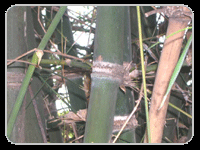
Culm sheths are modified leaves, arranged alternately on opposite sides of the growing culms, providing protective cover for the young shoots. The sheath is attached to the node.
clasp the culm and falls off leaving a scar after the culm becomes mature. Width of the sheath is greater than the circumference of the node so that the two sides of sheath overlap. The back of the sheath is usually covered with hairs that are irritant and easily detached when sheaths become old. The inner side of the sheath is smooth and shining. Early removal of culm sheaths will result in stunted growth of the culm.
Apart from its main protective body, the culm sheath consists of a blade, auricles and ligule. The distinct portion at the top of the sheath is the blade. The blade is smaller at the base of the culm and larger and leaf-like towards top. The blades may be erect or deflexed and are deciduous when the sheaths become old.
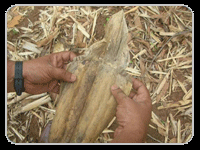
In some bamboo species, prominent ear-shaped structures are present at the pint of attachment of the4blade on the sheath. These laterally extended structures are called auricles; which play very important role in identification of bamboo species. The auricles may have hair-like bristles on their edges. The auricles are not deciduous but are fragile and easily broken.
The thin, short upward-growth on the inside top of the sheath, which clasps the culm is known as ligule. The shape, height, margin of the ligule and presence of hair etc. are some of the characteristics facilitating identification of bamboos. These characteristics are more prominent in young culm-sheath.
The general appearance, size and shape of culm sheaths, the structure and character of lade,auricle and ligule are considered as the best guide for identification of bamboo species.
Branching
Branches emerge from the nodes and are arranged on alternate side of the culm. The number of branches at each node varies according to the species. Normally one main branch and two or more secondary branches emerge from each node. The main branch is thick and long as compared to other auxiliary branches. In some species, branching is absent in the lower nodes up to a considerable length. However, in some other species branching starts from fourth inter node above the base. In case of few thorny species the lateral branches are hardened to spines providing natural arm our to clumps. The branches and branch lets bear profuse leaves. In many cases the branching pattern is considered as a characteristic for the genus.
Flowering of Bamboo
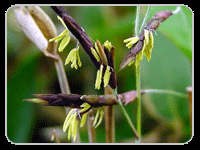
Like other plants, bamboo does not flower annually. In general, flowering and fruiting occurs only once during the lifetime at certain age of the clump after which it dies. The flowering cycle of bamboo varies from 7 years to 60 years depending upon the species. There are 3 different types of flowering.
Generally most bamboo species flower gregariously at fixed intervals and all culms including those of current year die after flowering .The Bamboo clumps belonging to a particular stock flower simultaneously. It has been reported that the entire population of a given species raised from the same seed source, no matter where they are situated, would flower at the same time. As a precaution, it is required to raise bamboo crop of different species to ensure constant supply of bamboos. In Salia bamboo (Dendrocalamus strictus) that is predominant in Odisha forests, both sporadic and gregarious flowering occur at long intervals of 20-65 years. Flowering is very rare in the two important bamboo species cultivated by villagers i.e. Bambusa nutans and Bambusa vulgaris.
Annual: The culms remain healthy after flowering.
Sporadic: Only some clumps in an area flower, bear seeds and die thereafter.
Gregarious: The whole population of bamboo, over an extensive area flower over a period of time and die out.
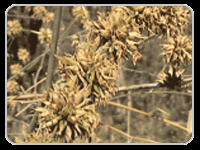
Flowering Records in Odisha
Bambusa arundinacea
1969, Koraput, Odisha, Gregarious flowering.
Reported by T. Das in Indian Forester, Bambusa arundinacea in Nowrangpur Division, Koraput District, Odisha.
Indian Forester 95(1969):p279
1976, South Odisha, Gregarious flowering
Reported by T. Das, Thorny bamboo bloomed-gregarious flowering of Kanta Bans death knell for Bambusa arundinacea clumps occurrence in South Odisha.
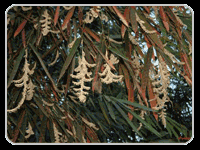
Indian Forester 102(1976):p473
Dendrocalamus Strictus
1939, Angul Forest Division, Odisha
Reported by M.L. Sen Gupta, 1939. Early flowering of Dendrocalamus strictus.
Indian Forester 65(8):583-585
1967, Odisha, Gregarious flowering
Reported by Sagar Singh, 1967. Gregarious flowering in bamboo (Dendrocalamus strictus).
Indian Forester (1967):p194
Fruit and Seeds
The fruit of bamboo is an indehiscent, one seeded caryopsis. The size and shape of bamboo fruit (seed) vary according to the species. The seeds have no dormancy and hence can be sown soon after collection to get higher percentage of germination. The seeds are also used as grains during scarcity period.
Uses Of Bamboo
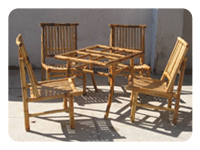
Bamboo, the poor mans timber is a strong, versatile and renewable woody materials having multifarious uses both in rural and urban sector. It has been an integral part of India's cultural, social and economic traditions. Millions of people depend on it for their livelihood and for household and functional uses. The unique properties of Bamboo; such as its strength, straightness, smoothness, durability, easy to cut and split, easy to carry; have made it useful to the villagers in almost every need of life. Besides being an essential component of cottage and rural industry, bamboo is also found to be used in some specialized uses such s tube well pipes, artificial limbs, and reinforcement in cement concrete etc.
The Indian Plywood Industries Research and Training Institute (IPIRTI),,Bangalore has developed many innovative products such as bamboo mat boards (BMB), bamboo mat veneer composites (BMVC), bamboo mat corrugated sheets (BMCS), bamboo mat tray (BMT), bamboo laminates and bamboo match sticks etc. by using bamboo as the raw material.

Banslochan (Tabasheer) a microscopically fine silicaceous matter found within the inter nodes of some bamboo species is used in Ayurvedic drugs to treat cough and asthma. Other l parts of bamboo such as roots, leaves, sap and a share used to treat a number ailments like cough, bile, fever, swelling, cuts, ring worm, bleeding gums and wounds etc.
However, the major commercial use of bamboo in Odisha has been for paper industries. Bamboos from forests were being supplied to Paper Mills of the State. As two of the four paper mills have been closed down and the other two have started using higher percentage of hard wood as raw materials; the bamboos harvested from forests td not fetch good market at present. Bamboos are used by man from the cradle to the coffin. It is the natures most valuable gift to mankind especially to rural people. Because of easy workability and low costs, bamboo has been useful to the general mass. The important characteristics, for which bamboo has been considered as the most cost effective woody material, are: